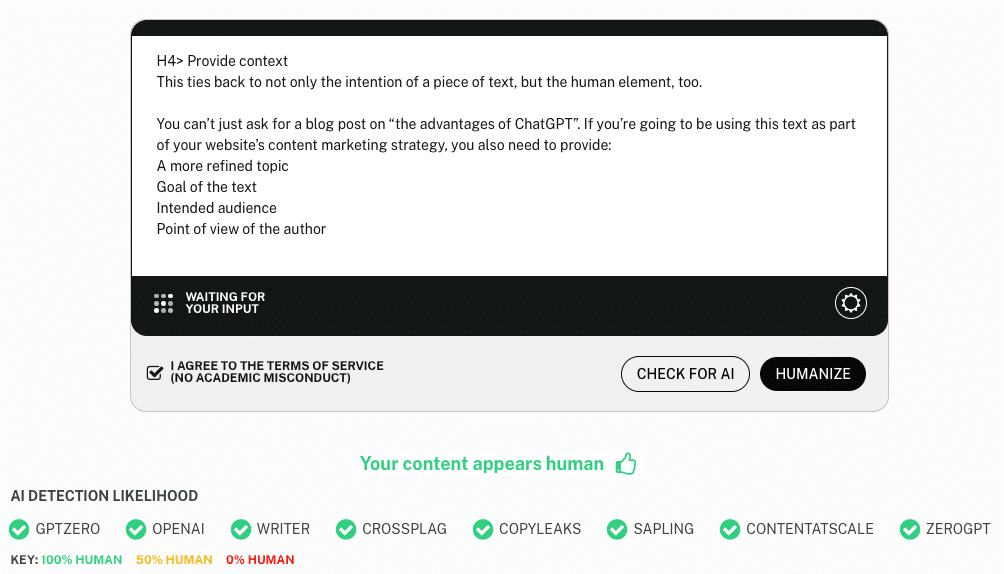Can you write a blog post using Chat GPT?
The answer to this question is somewhat loaded.
In short, absolutely you can.
You can enter a simple prompt and a required word count, and ChatGPT can spit out a blog post, complete with introduction, conclusion, and even metadata, in mere seconds.
So yes, it can produce a blog post in seconds… but is this blog post something you’d be happy to publish on your site?
Perhaps not. Let us explain.
5 disadvantages of ChatGTP for SEO and content marketing
ChatGPT and similar AI-powered tools have changed the way we generate content for marketing and website purposes.
However, it’s naive to ignore their limitations.
In our first-hand experience of ChatGPT’s capabilities, we’ve encountered several drawbacks that warrant consideration.
These limitations include issues around content quality and fact-checking, as well as the absence of the ‘human touch’ and the potential over-reliance on AI.
Here are five drawbacks of AI-generated content for SEO and digital marketing purposes.
1. ChatGPT struggles to create quality long-form content in one fell swoop
As mentioned in the example above, you can provide a prompt with as little or as much detail as you like, but in our experience, the output is far from perfect.
The result is often repetitive headings and body text, written in different ways but essentially saying the same thing.
It can lack flow and structure, and perhaps most telling, it often misses the purpose of the text you’re trying to create (whether that be to inform, educate, entertain, or market your services).
It’s perhaps more cumbersome to have to go through multiple iterations of a 700-word blog post with ChatGPT to fix up sections that require improvement.
2. ChatGPT can produces fluffy, wordy sentences
We often find that some long-form deliverables are full of superfluous sentences, long paragraphs, and general fluff.
Here’s what GPT produced when we asked it to provide a paragraph about using AI content generators for SEO:
“The integration of GPT into SEO strategies represents a groundbreaking paradigm shift, transcending conventional content optimization methods by harnessing the formidable power of artificial intelligence.”
That’s quite a mouthful!
Manually reviewing longer sentences and cutting unnecessary wording takes a human touch, and we think it’s critical in order to improve sentence structure and readability – especially for text that’s going on the web.
3. AI cannot verify facts
One of the biggest drawbacks lamented during AI’s infancy was that it was unable to fact check information it was providing.
In ChatGPT’s case specifically, it made it clear that its knowledge is based on information available up until January 2022. It also clarifies that it does not have access to real-time or current data, and cannot provide information past that date.
In fact, why not ask ChatGPT how it fact checks?
ChatGPT:
“I fact-check information by relying on a pre-trained dataset that includes a wide range of reputable sources and references up to my last update in January 2022. I use patterns in language and information present in the dataset to provide responses.
However, I do not have real-time access to external databases or the internet to verify the most current information. Users should verify critical information from up-to-date and reliable sources when making important decisions.”
4. ChatGPT lacks the “human touch”
If you’re a digital agency or content marketer, it’s likely that you are familiar with the style of writing ChatGPT generates.
In many cases, it can be easy to spot AI content; there’s something about the sentence structure, as well as tell-tale words repeatedly used, that stands out.
While AI is pretty good at natural, conversational text, it still lacks emotional intelligence. And no matter how smart AI is, it still can’t imitate the real, human touch.
5. Dependency
It’s a bit of a bleak thought to think that AI can replace everything we as digital marketers do.
In essence, as noted at the very top of this blog post, it can indeed produce a long piece of content in seconds… but the question is, is that piece of content good enough?
In some cases, it might be.
But in most, particularly when you – as the human – understand the intention of the text better than AI, you know that you cannot fully become dependent on it.
In short, AI can be used to finesse and improve text, generate ideas, and help kick-start a piece of content.
But no matter its level of intelligence, it simply cannot replicate emotional intelligence or the human touch, meaning it is something that – right now, at least – we cannot completely depend on.

How to effectively use ChatGPT
So, now that we have reviewed some of the drawbacks of AI content generators, let’s explore some simple strategies you can use in order to have better control over a piece of content.
Segment your text
When writing longer-form content, in our experience we’ve found it more beneficial to section your text. That means the initial work starts with you; you should first outline and determine:
- Topic
- Intention
- Audience
- Sections you wish to include
Then, work your way through each section, before moving onto the next. It can also be beneficial to leave the introduction for last, once the bulk of the body content is finalised.
Working section by section helps you to control the structure, the goal, and the readability, while leveraging ChatGPT to flesh out your ideas or improve readability.
Ask follow up questions
Segmenting your text makes it easier to finesse and refine your content.
Asking follow-up questions improves comprehension, enhances readability, and strengthens quality. It also helps to steer the conversation in the direction you need.
This way, you can ensure you’re happy with a single section before moving on to the next.
Too much back and forth on a longer portion of text – like an entire blog post! – simply becomes harder and far more cumbersome to navigate.
Provide context
This ties back to not only the intention of a piece of text, but the human element, too.
You can’t just ask for a blog post on “the advantages of ChatGPT”. Depending on how this text is to be used – for example, as part of your website’s content marketing strategy – you will also need to provide:
- A more refined topic
- Goal of the text
- Intended audience
- Point of view of the author
This could mean a prompt starts with something like:
A blog post about “the advantages of ChatGPT for content marketers” [refined topic] written from the point of view of an Australian-based SEO agency [the author].
The goal is to educate [goal] prospective SEO clients, including small business owners or in-house digital marketers [intended audience], that the opportunities of AI content creation come with drawbacks. However, there are solutions to work more effectively alongside AI.
Run your content through an AI checker
There are a ton of free tools that can analyse your text check if it may be detected as AI-generated. Some of our top choices include:
Undetectable (https://undetectable.ai/)
This is a great little tool that compares your content with a range of content generators. It gives you a score based on the likelihood of your text being generated by one of these tools.
Here’s an example of a portion of text from this very blog post, followed by the AI detection likelihood score:

AI content detector (https://writer.com/ai-content-detector/)
Writer.com’s AI detector is great for when you want to quickly check shorter snippets of text, such as product descriptions or category content. It is limited to 1500 characters at a time.
Don’t forget that you’re in control!
While ChatGPT and other AI content generators can make your job of writing easier and more streamlined, it cannot replace it – particularly when your goal is to create web-friendly, SEO-optimised text.
AI is a tool that can enhance your work, but it can’t replicate the authenticity, quality, and usefulness that can only be provided with human input.
At the end of the day, nothing beats authentic sentiment, quality writing, and useful information – and in many cases, these just aren’t possible with AI alone. As such, AI should be used as an aid, not a complete substitute.
AI is designed to work with you – not to take your place. Your creativity, insights, and unique perspective are irreplaceable, and they play a crucial role in producing content that resonates with your intended audience. Embrace AI as a helpful tool, but remember that ultimately, you’re in control!